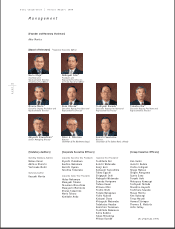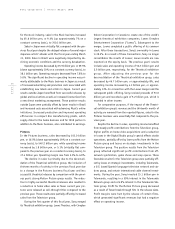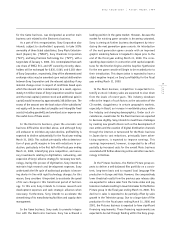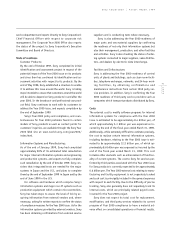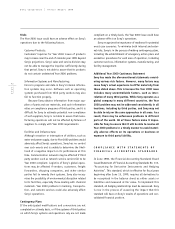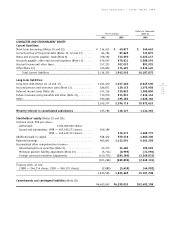Sony 1999 Annual Report Download - page 40
Download and view the complete annual report
Please find page 40 of the 1999 Sony annual report below. You can navigate through the pages in the report by either clicking on the pages listed below, or by using the keyword search tool below to find specific information within the annual report.
Sony Corporation Annual Report 1999
38
page
Other
The Other business consists of various operating activities,
primarily including leasing and credit card businesses, a
business focused on parts trading services within the Sony
group, satellite distribution services including program sup-
plying businesses in Japan, internet-related businesses in
the U.S., and development of location-based entertainment
complexes. Sales in Other business grew by 39.1 billion yen,
or 15.8%, to 287.3 billion yen but Other businesses con-
tinued to post an operating loss.
The sales increase was due principally to the new con-
solidation of certain subsidiaries, and a sales increase in a
financial subsidiary in Japan whose major business is leas-
ing and credit cards. Approximately 70 percent of sales in
Other business reflected intersegment transactions in the
fiscal year ended March 31, 1999.
Operating losses were incurred in the start-up of long-
term strategic businesses, including satellite distribution
services in Japan, internet-related businesses in the U.S.,
and location-based entertainment complex businesses.
Development of location-based entertainment complexes
is in progress in San Francisco, Berlin, and Tokyo. In San
Francisco, an entertainment complex including stores and
theatres will open in June 1999. The budget for this project
was approximately 13.8 billion yen. In Berlin, Germany, a
building complex to house Sony’s European headquarters,
rental office space, stores, residences, a movie and broad-
casting museum with educational facilities, and entertain-
ment space is currently under construction. The structure is
located in Potsdamer Platz. This project is being carried out
by a partnership controlled and operated by Sony, Tishman
Speyer Properties, Inc. in the U.S., and Kajima Corporation
in Japan. Completion is scheduled for 2000. The budget for
this project is approximately 1.5 billion German marks, of
which approximately 1.0 billion German marks has been ar-
ranged by the partnership in the form of non-recourse project
financing. Sony contributed the land and 19.8 billion yen
in cash in the form of preferred equity in the partnership.
Sony also plans to construct a similar entertainment com-
plex in Tokyo, Japan, with completion scheduled in the spring
of 2000. For this project, Sony will lease commercial space
from Battery Town 21 Co., Ltd. The budget for this project
is approximately 13.0 billion yen.
STRATEGIES AND OUTLOOK
This section contains forward-looking statements about
the future performance of Sony and should be read in
light of the cautionary statement on that subject, which
appears on inside front cover page and applies to this
entire document.
Sony’s management is endeavoring to develop the most
appropriate plans for its businesses, considering the cur-
rent general economic and operating environment and avail-
able information. The following is a summary of certain of
Sony’s current basic strategies and outlook for its fiscal year
ending March 31, 2000.
It is expected that difficult business and economic cir-
cumstances will continue, including economic difficulties
in Russia and Eastern Europe and in Latin America, further
appreciation in the value of the yen, and increasing price
competition. In these circumstances, Sony seeks to hold
the decrease in its sales to a minimum for the fiscal year
ending March 31, 2000 compared with that for the fiscal
year ended March 31, 1999. However, earnings are expected
to decline substantially.
Digitization is accelerating in the business of audiovi-
sual equipment, where Sony has maintained its ‘core com-
petence’. Accordingly, competition is intensifying because,
in addition to current competitors, many others with new
technologies are participating in the market. In order to
achieve growth in these circumstances, Sony believes the
key factors are to maintain its brand value in the market
and to accelerate the pace of changes within Sony. In terms
of maintaining brand value, Sony intends to enhance re-
search and development activities and streamline manufac-
turing systems, with the goal of enhancing the value of
products and expanding market share. In terms of accelera-
tion of changes, Sony’s management has reorganized its
group structure so as to enhance prompt decision-making.
At the same time, while delegating increased authority to
its newly formed business units, Sony is strengthening its
governance necessary for its group management.
On March 9, 1999, Sony Corporation announced changes
in its group structure to prepare Sony for a network-centric
era. Effective April 1, 1999, the existing Electronics business
was consolidated into three main business units. Separately,
Sony Computer Entertainment (“SCE”), which is responsible


